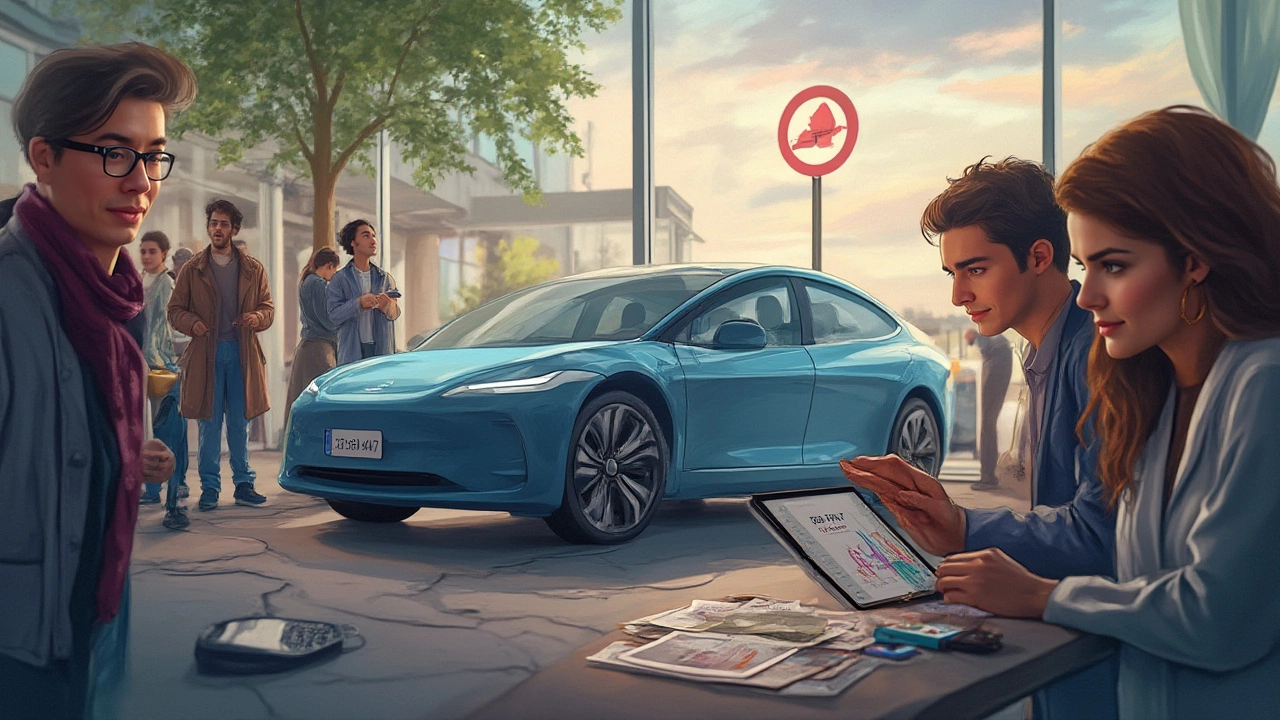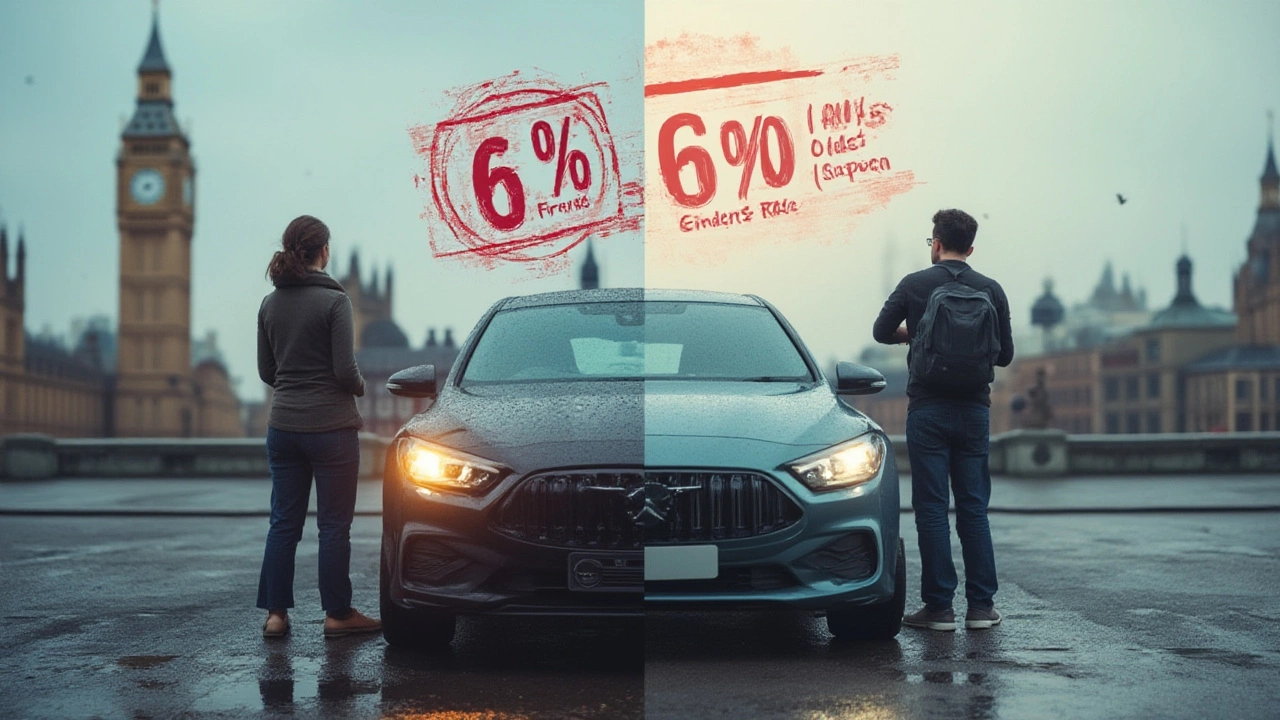Is 6% APR High for a Car Loan? 2025 Car Financing Facts, Tips, & Comparisons
 Jul, 5 2025
Jul, 5 2025
Remember that feeling when you finally find the perfect car, run your numbers, and then get blindsided by what looks like a random percentage—the APR? This isn’t just a small footnote on your loan offer. That annual percentage rate (APR) can make the difference between riding easy and spending years regretting your financing. Right now, in 2025, a 6% APR for a car loan sounds almost like a sweet spot to folks who endured the sky-high rates of 2023 and 2024, but is it really a good deal? Let’s pull back the curtain and see what 6% means for your wallet, your credit, and whether banks are giving you a thumbs up or just laughing to themselves.
Understanding What 6% APR Means for Car Loans in 2025
Let’s start simple: APR (Annual Percentage Rate) isn’t just raw interest on the loan. It’s the official all-in cost, mixing interest with lender fees and sneaky fine print stuff. So when you’re quoted a 6% APR, it’s a comprehensive look at what borrowing will cost you over a year.
The catch? 6% might sound average, but there’s no “one size fits all” when it comes to car loans. Lenders consider your credit score, the age of the car, loan term, down payment, and even reindeer-bizarre things like the lender’s mood that month. It’s personal, and market conditions throw a wrench in your plans too.
In early 2025, the Bank of Canada’s key interest rate finally started cooling down after hovering above 5% for nearly eighteen months. Between 2022 and 2024, car buyers dealt with rates stretching to 7–10%—some unlucky folks with bad credit saw numbers scraping double digits. Now, banks and credit unions are advertising car loan APRs ranging from 4.8% to 8.7% for folks with good credit, with the averages settling near the 6% mark. So if you’re looking at 6%, you’re definitely not alone—it's very much smack in the middle of what most Canadians and Americans are getting in 2025.
Let’s break it down. Say you finance $35,000 (not a stretch for a new SUV or EV) over five years (60 months) at a 6% APR. Here’s how that shakes out:
| Loan Amount | Term | APR | Monthly Payment | Total Interest Paid | Total Cost |
|---|---|---|---|---|---|
| $35,000 | 60 months | 6% | $676.15 | $5,569 | $40,569 |
| $35,000 | 60 months | 4.5% | $654.78 | $4,286 | $39,286 |
| $35,000 | 60 months | 8% | $710.59 | $7,635 | $42,635 |
So, getting 6% instead of 4.5% costs you nearly $1,300 more in interest over five years. But jump to 8% and you’re paying a whopping $2,000 more than the 6% loan. These little percentage points can add up to more than one year’s worth of fuel, insurance, or those out-of-nowhere repair bills.
Here’s another fun wedge: In 2019, average Canadian car loan APR for great credit was 3.99%. In 2023, it spiked to over 7%. Payment shock is real. In 2025, we’re on a downswing, but nobody’s calling 6% “low.” It’s just not highway robbery either.

Is 6% APR High for a Car? Factors That Change the Answer
The quick answer: It depends who you are, what you drive, how long you’ll be paying, and if you put any money down. For most buyers with good (not stellar) credit in 2025, a 6% APR is about average. Here’s the nitty-gritty on the details that really matter.
Credit Score: The big kahuna in auto lending. Right now, if you have a credit score above 750, you might be able to wrangle a rate closer to 5%—even below—especially at a dealer-sponsored event on select models. Land in the 650–700 zone, and 6% may be the best on offer. Drag into subprime (below 630) and lenders love to toss you right into the 8–12% zone or higher. That’s major pain on your wallet, especially if you’re stretching out to six or seven years.
Car Age & Type: New cars get better rates. Used cars usually cost more to finance, because lenders see more risk and less resale value. And if you’re taking out a loan on a ten-year-old truck with 225k on the dial, don’t expect luxury rates. Some lenders refuse to finance old vehicles at all post-pandemic, or they hit you with small-print fees.
Loan Term: The longer you stretch your loan, the more you pay in interest, no matter the rate. Five-year terms remain the Canadian average, but plenty of folks sign for six, seven, or even eight years. Lenders love long loans: more interest for them, more total cost for you. Always check the total cost, not just the monthly payment.
Region: Canadians see higher rates compared to U.S. shoppers, thanks to different central bank policies. Car financing in Ontario is pretty typical, but out east and in the Prairies, there are sometimes incentives or higher risk premiums. Toronto’s average right now: 5.9% to 7.2% for prime buyers through a dealer or major bank. Credit unions have inched a bit below 6%, but not by much.
Down Payment: Drop at least 10–20% and you’ll see better rates. Zero down equals higher perceived risk, so expect to pay more to borrow the same car.
Here’s a weird fact: The average car loan amount in Canada hit $43,500 this spring—the highest ever. This means any bump in interest rates hits even harder than years past. A couple of years ago, $400 monthly payments were common. Now, $650–$700+ is “normal.”
Looking for a lower monthly payment? Some buyers are stretching loans to seven or eight years, but remember, you’re upside-down longer, and end up paying thousands more in interest. That’s a risky game if job security or life changes lurk around the corner.
And it isn’t just about the numbers: dealers are still tacking on sneaky lender “document” and “preparation” fees, ranging anywhere from $295 to $1,200. Compare every offer, and insist on a full APR disclosure, so you’re not tricked by an artificially “low” interest rate loaded with hidden fees elsewhere.
If you’re not in a hurry, waiting six months to a year might get you a better rate. Pros expect modest drops if the Bank of Canada cuts rates as inflation cools, but don’t bank on a repeat of the ultra-low COVID-era days.
The key takeaway: 6% APR for a car isn’t outrageously high right now. But it also isn’t “cheap.” With the right credit score, the right car, and a bit of luck, you might be able to trim that number. But don’t expect miracles.

How to Score a Better Car Loan Rate: Real-World Tactics for 2025
Feeling like 6% APR is borderline but craving something better? It’s worth rolling up your sleeves—there are proven tricks to get yourself a sweeter deal, even when lenders seem inflexible.
- Know Your Credit Score, and Fix It If You Can: Pull your credit report before shopping. Got errors? Dispute them. Sitting just below a 700? Paying down a single credit card or resolving an old phone bill might bump you into a lower bracket, worth thousands in savings.
- Shop Your Own Bank and Credit Union: Sometimes your longtime bank will offer loyalty discounts, or credit unions will cut better rates than big banks and dealer financing. Especially in Ontario, credit unions sometimes stay a half-point below the major lenders.
- Time Your Shopping: End of the month or quarter is when salespeople panic about quotas—dealers are far more likely to eat a few hundred bucks to close a sale, so leverage that.
- Make a Hefty Down Payment: Even $2,500 down could trigger a rate drop, or at least save you on total interest. Lenders like to see skin in the game.
- Skip Add-ons and Upsells: Extended warranties and insurance bundles often inflate your total cost (and get tacked onto the loan, racking up more interest). Take the cash price and opt out if you want real savings.
- Shorten Your Loan Term If You Can: Yeah, the payment will rise, but you’ll pay a lot less interest. Use online calculators to compare real totals over different terms—it’s eye-opening.
- Negotiate Rate, Not Just Monthly Payment: Dealers love to “hide” markups by stretching terms, but focus on getting the lowest APR and the shortest possible loan you can afford.
- Bring Pre-Approval When You Shop: It’s not just good for your negotiating power; it also stops dealers from running multiple “hard” credit checks, which can ding your score and push your rate higher.
- Read All Disclosures: Some lenders will offer “balloon payments” or deferred interest—be wary. These can leave you owing way more than you expected at the end of your term.
Looking for wild savings? In 2025, a few manufacturers (especially for electric cars) are offering special 0.99% or 1.99% APR promotions, but they’re rare and almost always limited to top credit tiers and certain models. If you see one, act fast—but double check that other incentives or discounts aren’t getting removed in exchange.
One last trick: Don’t be embarrassed to walk away if the numbers don’t add up. Dealers count on emotional buying. Pausing for a day or two to crunch your own numbers can save you hundreds, if not thousands, in interest and hidden costs.
So, is 6% APR car loan high? It’s not the deal of a lifetime, but for most buyers in 2025, it’s right in the middle lane—not a ripoff, not a steal. If you’re credit-worthy, shop smart, and negotiate hard, you just might edge your way towards a better rate—and, more important, a payment that leaves you enough breathing room for everything else life throws your way.
